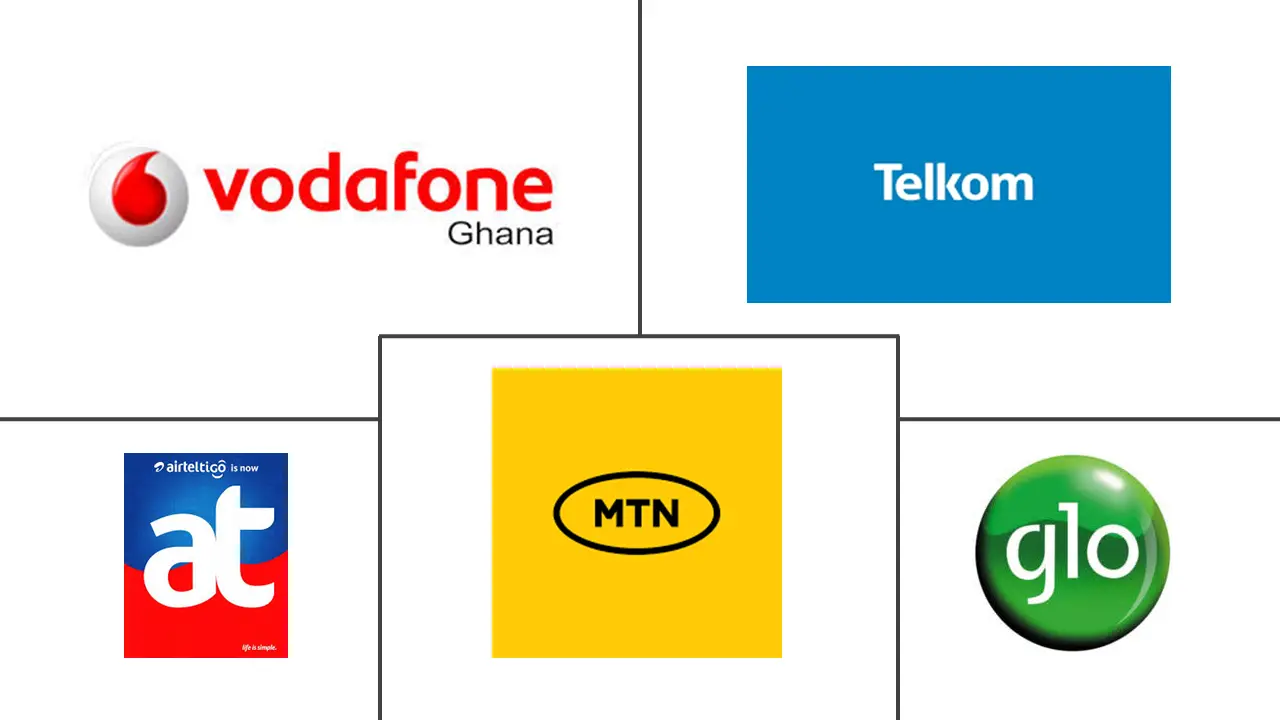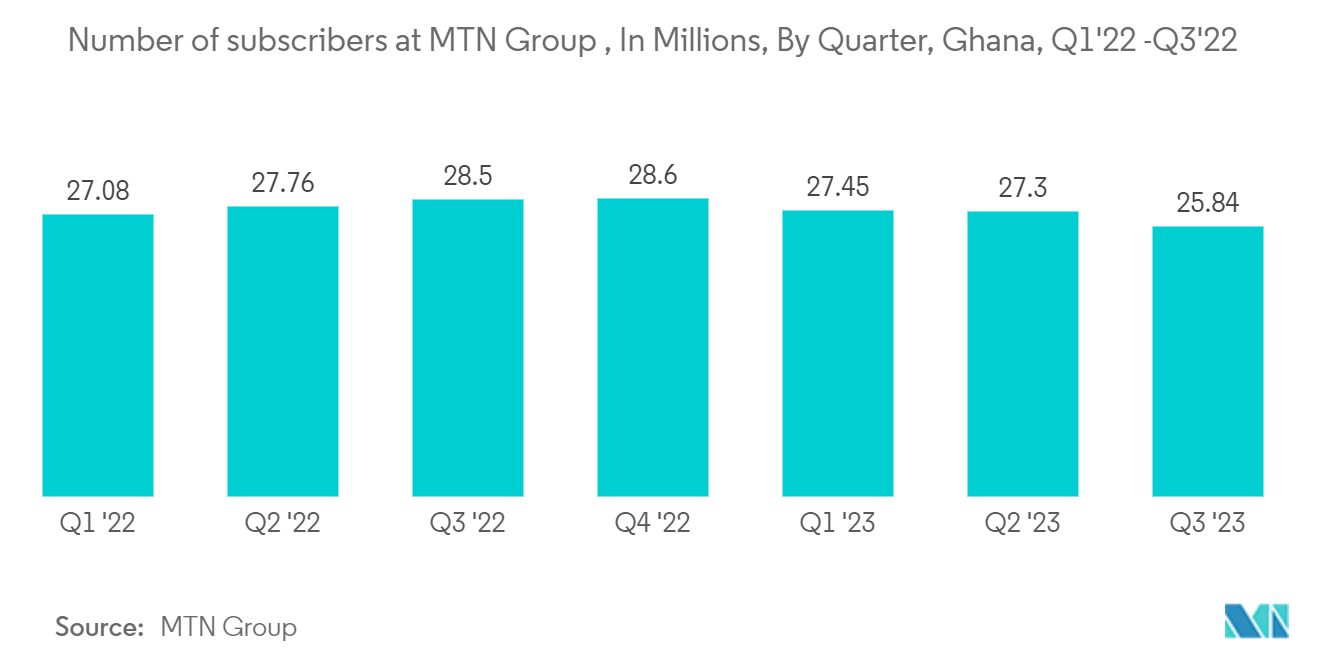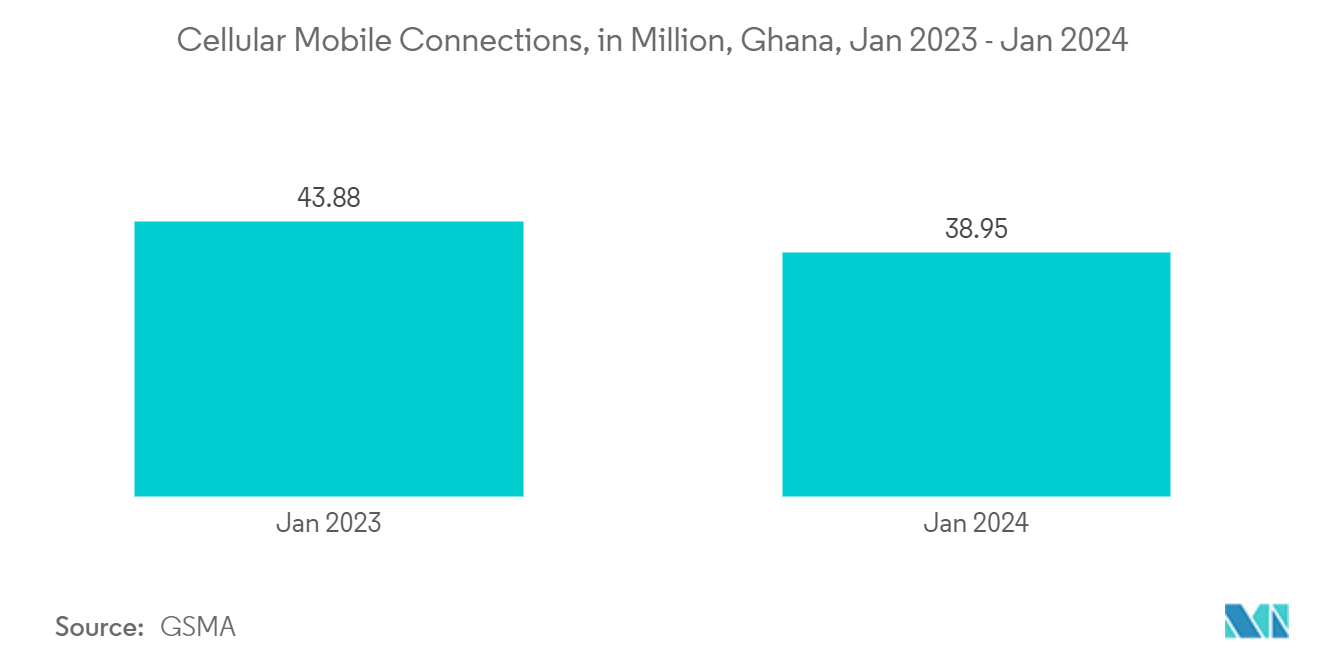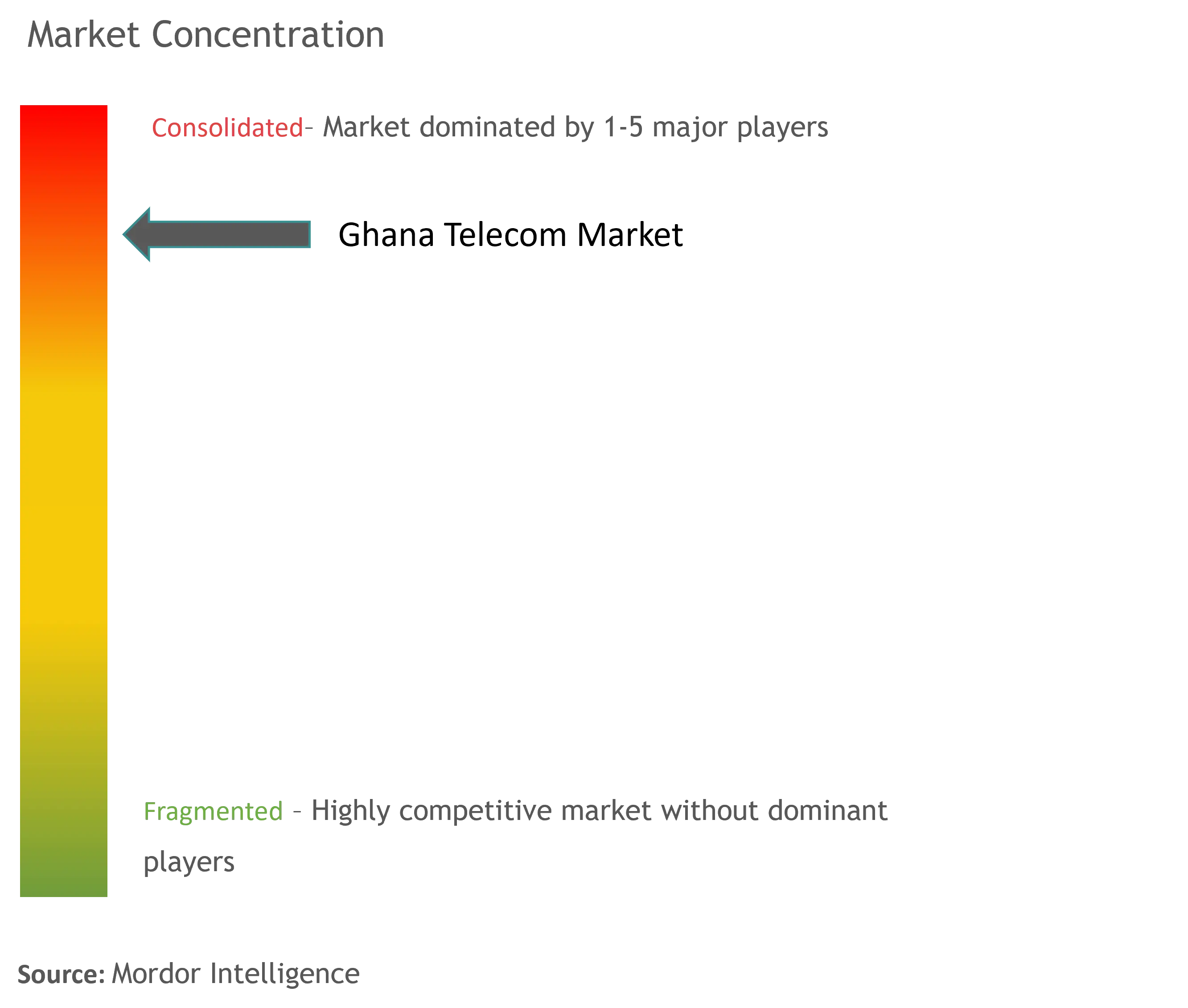Ghana Telecom Market Analysis
The Ghana Telecom Market size is estimated at USD 1.10 billion in 2025, and is expected to reach USD 1.17 billion by 2030, at a CAGR of 1.12% during the forecast period (2025-2030).
- The country is witnessing a surge in demand for 5G connections and services, propelled by the technology's promise of faster speeds and lower latency than its predecessors. 5G enables seamless streaming and real-time communication and facilitates quicker downloads. This, in turn, is bolstering the demand for telecom services. The rising preference for video streaming, online gaming, and other data-heavy applications further underscores the need for enhanced data speeds and capacity. With 5G, telecom operators are better equipped to cater to the escalating mobile data consumption, paving the way for increased revenue prospects.
- The country’s manufacturing industries have adopted Industry 4.0, transforming industries from legacy systems to smart components and machines, primarily to facilitate digital factories and develop an ecosystem of connected plants and enterprises. Industry 4.0 persuaded OEMs to adopt IoT across their operations. Long-range, low-power, wide-area network (LPWAN) technologies, such as NB-IoT, LTE-M, and LoRa, drive innovation for IoT connectivity. LPWANs for IoT sensors are expected to allow low-powered devices to stream data packets wirelessly but with a broader area required in a manufacturing facility.
- The push to enhance internet connectivity in rural areas is a crucial driver behind the expansion and enhancement of the telecommunications sector in the country, fueling market growth. Factors like rising smartphone penetration, growing awareness, increased digital technology usage, and investments from organizations and governments bolster internet adoption. Additionally, the rise of KaiOS and partnerships with African operators make internet access more affordable for low-income users. Complementary resources, like the 'Life' app, are aiding new users in developing digital skills and grasping the internet's relevance. These initiatives are poised to elevate internet penetration rates in these nations notably.
- Telecom companies increasingly focus on digital transformation to enhance customer experience, optimize operations, and offer new services such as cloud-based solutions, digital payments, and streaming services. As digital connectivity increases, so does the importance of cybersecurity. Telecom companies have the opportunity to provide robust cybersecurity solutions to businesses and consumers to protect against cyber threats. Also, developing smart infrastructure, including smart buildings and smart energy grids, requires advanced telecom networks for data transmission and management, creating opportunities for telecom providers to offer integrated solutions.
- On the contrary, several factors are propelling competition in the telecom industry. For example, the increasing demand for telecom services, including voice and data services, has also forced competitors in the industry. Companies are constantly expanding their networks and services to meet the growing demand from consumers. Further, price is also a significant factor propelling competition in the telecom industry. Customers are increasingly price-sensitive, and companies constantly strive to offer more affordable services to attract and retain customers.
Ghana Telecom Market Trends
Mobile Network is Expected to Propel the Market
- Smartphones are used for both personal and professional purposes. Apps enable various activities, such as access to social media platforms, health and wellbeing tracking, and mobile payments. Due to an increase in the number of smartphone users connecting to faster networks and using more significant amounts of data, smartphone capacity has also increased mobile internet traffic. This has created new opportunities for networks, service providers, and the broader Ghana telecommunications industry to meet this growing demand. Additionally, they spend most of their time using social and communication apps. Businesses connect with their customers in countless ways, given how frequently and intensely they use their smartphones. Hence, these factors will boost smartphone adoption in the country during the forecast period.
- Ghana's internet infrastructure has grown significantly due to the increasing demand for internet access to support its economic growth. Additionally, the government has invested in developing mobile networks, enabling many country locations to access mobile telecom services, such as mobile broadband. Enterprises in the country need access to dependable, high-speed internet because of the country's digital transformation and online services, creating an opportunity for mobile broadband connectivity because the internet through mobile broadband architecture is more portable and affordable due to the application of SIM cards in mobile broadbands.
- In 2023, MTN committed to investing USD 1 billion in Ghana over the next five years. Despite this, Ghana's 4G adoption remains low, with only 15% of mobile users utilizing the technology by mid-2023. MTN Ghana stands out as the nation's primary 4G provider, boasting 5.7 million active 4G subscriptions by June 2023, a significant portion of its 27.8 million total mobile user base. In contrast, Vodafone Ghana had a mere 341,600 4G subscriptions from its 7.3 million mobile users, while AirtelTigo and Glo Mobile lagged, reporting no 4G users. Ghana's regulatory body intensified its efforts against unregistered SIM cards, leading to the disconnection of approximately 9 million SIM cards in June 2023, until users completed mandatory registration.
- Moreover, as the technology reduces the need to develop additional instrumentation that must be managed and operated, NB-IoT prepares for a wider audience. NB-IoT can connect Narrowband IOT applications directly and will likely become more widespread as urbanization continues. Narrowband-IoT, also known as LTE Cat NB1, is a Low-Power Wide-Space (LPWA) network technology typically used to connect many sensitive sensors and devices via a wireless cellular network. The commissioned spectrum is where NB-IoT devices operate, providing users with safe and reliable property.
- The voice services include the voice telecom services provided by the country’s telecom operators through wire-based architecture and technology, such as landline phones, which previously dominated the telecom market in the country. Still, with the advancement of cell phones and other wireless devices for communication, the wired-based voice service is registering a continuous decrease in adoption. In addition, wire-based telecommunication services are being utilized for data services in the country because of their high stability, but due to the less flexibility and portability, wired voice services are gradually being replaced by wireless voice services, including the Voice over Internet Protocol.
Wireless Segment is Expected to Hold Significant Share
- The Government acknowledges the rapid evolution of technology and markets in the telecommunications sector, a trend that is expected to persist in the coming years. Recognizing the need for adaptability, the traditional telecommunications market in Ghana must pivot to accommodate new services, diverse marketing strategies, and evolving customer preferences. While an immediate overhaul of the current market structure is impractical, this Policy aims to outline a foundational vision for future market structures that will best serve Ghana's populace and enterprises. Additionally, it aims to initiate procedures and incentives that will steer the market towards this envisioned future.
- Moreover, Securing formal authorization for a designated frequency band is imperative for any domestic telephone operator aiming to offer services through wireless radio transmission. Once granted, the operator gains exclusive rights to utilize the spectrum for public telephone services, as outlined in their license terms. However, operators are bound by stringent service quality standards and must ensure their transmissions do not unduly interfere with other licensed holders' signals.
- The country has developed a competitive telecom business. The market's prospects improve as more international investors and players enter, and government support develops. Both private and public sector companies are actively investing in the market, supporting its growth. According to GSMA Intelligence data reveals that Ghana boasted 38.95 million cellular mobile connections at the onset of 2024, representing a penetration rate of 113.1% of the population. Additionally, Meta's planning tools highlight a significant growth in Instagram's potential ad reach in Ghana, surging by 500,000 users, a notable 29.4% increase from January 2023 to January 2024.
- The are various trends that are expected to drive the market. For example, The incorporation of advanced technology in the telecom sector is expected to drive the market. For instance, in the telecom sector, organizations are increasingly recognizing that while AI presents significant opportunities, it also brings formidable challenges. To succeed, telcos must gather extensive datasets, even those from external partners, swiftly transfer and process this data, and promptly leverage the insights to enhance business outcomes.
- Further, trends that may drive the studied market in the region include Cloud computing is familiar. Still, most telecom businesses rely on proprietary data centers to house most of their IT infrastructure. This will change in the future of telecoms as corporations shift critical infrastructure to the cloud. This transfer will increase scalability and allow telecom providers to adapt to swings in demand more effectively. This scalability will allow these organizations to bring new services to market more quickly and analyze demand before making large, unrecoverable infrastructure expenditures in goods that fail to acquire traction. This will be especially crucial in the context of 5G, as new apps and digital services join the market during an economic slump, which can greatly impact client demand.
Ghana Telecom Industry Overview
The Ghana Telecom market is consolidated, with a few prominent players such as MTN Ghana, Vodafone Ghana, AT Ghana, Globacom Limited, and Telkom Internet to increase market share; corporations continually spend on strategic partnerships or acquisitions services development. The following are some recent market developments:
- January 2024: Telecel Group, a player in the telecommunications sector, has revealed its strategic move: Vodafone Ghana is set to undergo a complete rebranding, transitioning to the Telecel banner by the close of February 2024. This decision follows Telecel's acquisition of a substantial 70% stake in Vodafone Ghana (officially known as Ghana Telecommunications Company Limited – GTCL) in February 2023. The rebranding initiative extends beyond Vodafone Ghana itself, encompassing its trio of subsidiaries: National Communication Backbone Company Limited (operating as Vodafone Wholesale), Vodafone Ghana Mobile Financial Services Limited (branded as Vodafone Cash), and the philanthropic arm, Vodafone Ghana Foundation. Demonstrating its commitment to the Ghanaian market, Telecel bolstered its presence in October 2023 by expanding its network infrastructure with 300 new 4G sites and introducing the advanced 4G+ technology, promising even swifter speeds to its clientele.
- November 2023: AT, the Ghanaian operator formerly Airtel Tigo, entered a joint venture with private equity firm Hannam Investments, signaling a strategic move to bolster the nation's telecoms sector. The primary goal of this partnership is to modernize Ghana's telecom infrastructure, emphasizing establishing a premier 4G network. Hannam Investments, emphasizing a customer-centric approach, highlighted that this venture will pave the way for a diverse range of cutting-edge telecom products and services. The founder of Hannam Investments further underscored the partnership's potential to attract additional investments, drive technological progress, and enhance telecom coverage in Ghana.
Ghana Telecom Market Leaders
-
MTN Ghana
-
Vodafone Ghana
-
AT Ghana
-
Globacom Limited
-
Telkom Internet
- *Disclaimer: Major Players sorted in no particular order
Ghana Telecom Market News
- May 2024: The Government of Ghana, alongside Ascend Digital, K-NET, Radisys, Nokia, and Tech Mahindra, has partnered with Mobile Network Operators (MNOs) AT Ghana and Telecel Ghana, to form a new shared infrastructure company, Next-Gen InfraCo (NGIC). This strategic alliance is geared towards making 5G mobile broadband services more accessible throughout Ghana. NGIC, having secured a 5G license, is set to roll out 5G services in Ghana in the coming six months, with plans for further expansion into other African regions.
- May 2024: Reliance Industries Ltd (RIL), known for its telecom arm Jio's dominance in India, is expanding its horizons to Africa. It has partnered with Ghana's Next-Gen InfraCo (NGIC) to introduce high-speed 5G internet services. NGIC, in turn, has collaborated with Radisys Corp, a subsidiary of RIL, to secure the necessary hardware and software for the 5G rollout in Ghana, a nation in Western Africa classified as a low-to-middle-income economy. Notably, RIL currently does not have a direct equity stake in NGIC. The primary stakeholders in NGIC are Ascend Digital Solutions Ltd. and K-NET, both African telecom firms, collectively owning 55% of the company. The Ghanaian government holds a 10% stake.
Ghana Telecom Industry Segmentation
Telecommunications services encompass the public network infrastructure, data transmission, and essential voice communication services. These include fixed and mobile phone services, network and data communication, and information services.
The Ghana telecom market is segmented by service type. By service the market is segmented into voice services data and messaging services, OTT and pay-tv services, and voice service is further segmented into wired, and wireless. For each segment, the market size is provided in terms of value (USD).
| By Service Type | Voice Services | Wired |
| Wireless | ||
| Data and Messaging Services | ||
| OTT and PayTV Services |
Ghana Telecom Market Research FAQs
How big is the Ghana Telecom Market?
The Ghana Telecom Market size is expected to reach USD 1.10 billion in 2025 and grow at a CAGR of 1.12% to reach USD 1.17 billion by 2030.
What is the current Ghana Telecom Market size?
In 2025, the Ghana Telecom Market size is expected to reach USD 1.10 billion.
Who are the key players in Ghana Telecom Market?
MTN Ghana, Vodafone Ghana, AT Ghana, Globacom Limited and Telkom Internet are the major companies operating in the Ghana Telecom Market.
What years does this Ghana Telecom Market cover, and what was the market size in 2024?
In 2024, the Ghana Telecom Market size was estimated at USD 1.09 billion. The report covers the Ghana Telecom Market historical market size for years: 2019, 2020, 2021, 2022, 2023 and 2024. The report also forecasts the Ghana Telecom Market size for years: 2025, 2026, 2027, 2028, 2029 and 2030.
Ghana Telecom Industry Report
Statistics for the 2025 Ghana Telecom market share, size and revenue growth rate, created by Mordor Intelligence™ Industry Reports. Ghana Telecom analysis includes a market forecast outlook for 2025 to 2030 and historical overview. Get a sample of this industry analysis as a free report PDF download.







